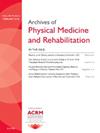有氧运动对有持续性脑震荡后症状的成年人的症状负担和生活质量的影响:ACTBI随机临床试验》。
IF 3.6
2区 医学
Q1 REHABILITATION
Archives of physical medicine and rehabilitation
Pub Date : 2025-02-01
DOI:10.1016/j.apmr.2024.10.002
引用次数: 0
摘要
目的评估为期6周的症状阈值以下有氧运动方案(AEP)与拉伸方案(SP)对患有持续性脑震荡后症状(PPCS)的成年人的症状负担和生活质量(QoL)的影响:有氧运动治疗轻度脑损伤后慢性症状(ACTBI)试验是一项随机对照试验,分为两组:环境:脑损伤、疼痛和理疗门诊:共筛选了 210 名参与者。连续抽样调查了 52 名轻度脑外伤后患有 PPCS 和运动不耐受的成年人。没有参与者因干预的不良反应而退出:参与者被随机分配到为期6周的AEP(27人)或为期6周的SP(25人):主要结果和测量指标:主要结果是Rivermead脑震荡后症状问卷(RPQ)。次要结果包括使用脑损伤后生活质量问卷(QOLIBRI)进行的QoL,以及情绪、焦虑、头痛的功能影响、疲劳、头晕、运动耐受性和睡眠等方面的测量:参与者平均(标清)43.0(10.9)岁(75%为女性),伤后24.7(14.0)个月。在按方案分析中,RPQ的组间差异(AEP vs SP)不显著,但QOLIBRI从基线到6周的组间差异显著(平均变化=5.024,95% Cl [0.057,9.992],p=0.047)。在意向治疗分析中,主要和次要结果的组间变化不显著:这项试验提供了初步数据,支持为患有 PPCS 的成人开具有氧运动处方。尽管出现了运动不耐受的情况,但参与者仍能进行症状阈值以下的运动,并获得了生活质量方面的益处。本文章由计算机程序翻译,如有差异,请以英文原文为准。
Effect of Aerobic Exercise on Symptom Burden and Quality of Life in Adults With Persisting Post-concussive Symptoms: The ACTBI Randomized Controlled Trial
Objective
To evaluate a 6-week sub-symptom threshold aerobic exercise protocol (AEP) versus a stretching protocol (SP) on symptom burden and quality of life (QoL) in adults with persisting post-concussive symptoms (PPCS).
Design
The Aerobic exercise for treatment of Chronic symptoms following mild Traumatic Brain Injury (ACTBI) Trial was a randomized controlled trial with 2 groups.
Setting
Outpatient brain injury, pain, and physiotherapy clinics.
Participants
A total of 210 participants were screened. A consecutive sample of 52 adults with PPCS and exercise intolerance after mild traumatic brain injury were enrolled. No participants withdrew because of the adverse effects of the intervention.
Interventions
Participants were randomized to a 6-week AEP (n=27) or 6-week SP (n=25).
Main Outcome and Measures
The Rivermead Post Concussion Symptoms Questionnaire was the primary outcome. Secondary outcomes included QoL using the QoL After Brain Injury Questionnaire, in addition to measures of mood, anxiety, functional impact of headache, fatigue, dizziness, exercise tolerance, and sleep.
Results
Participants were a mean (SD) of 43.0 (10.9) years old (75% female) and 24.7 (14.0) months post-injury. In per-protocol analysis, between-group difference (AEP vs SP) was not significant for the Rivermead Post Concussion Symptoms Questionnaire, but QoL After Brain Injury Questionnaire between-group difference was significant (mean change=5.024; 95% Cl, 0.057-9.992; P=.047) from baseline to 6 weeks. In the intention-to-treat analysis, between-group changes in primary and secondary outcomes were not significant.
Conclusions
This trial provides preliminary data to support the prescription of aerobic exercise for adults with PPCS. Despite presenting with exercise intolerance, participants were able to engage in subsymptom threshold exercise with QoL benefits.
求助全文
通过发布文献求助,成功后即可免费获取论文全文。
去求助
来源期刊
CiteScore
6.20
自引率
4.70%
发文量
495
审稿时长
38 days
期刊介绍:
The Archives of Physical Medicine and Rehabilitation publishes original, peer-reviewed research and clinical reports on important trends and developments in physical medicine and rehabilitation and related fields. This international journal brings researchers and clinicians authoritative information on the therapeutic utilization of physical, behavioral and pharmaceutical agents in providing comprehensive care for individuals with chronic illness and disabilities.
Archives began publication in 1920, publishes monthly, and is the official journal of the American Congress of Rehabilitation Medicine. Its papers are cited more often than any other rehabilitation journal.

 求助内容:
求助内容: 应助结果提醒方式:
应助结果提醒方式:


